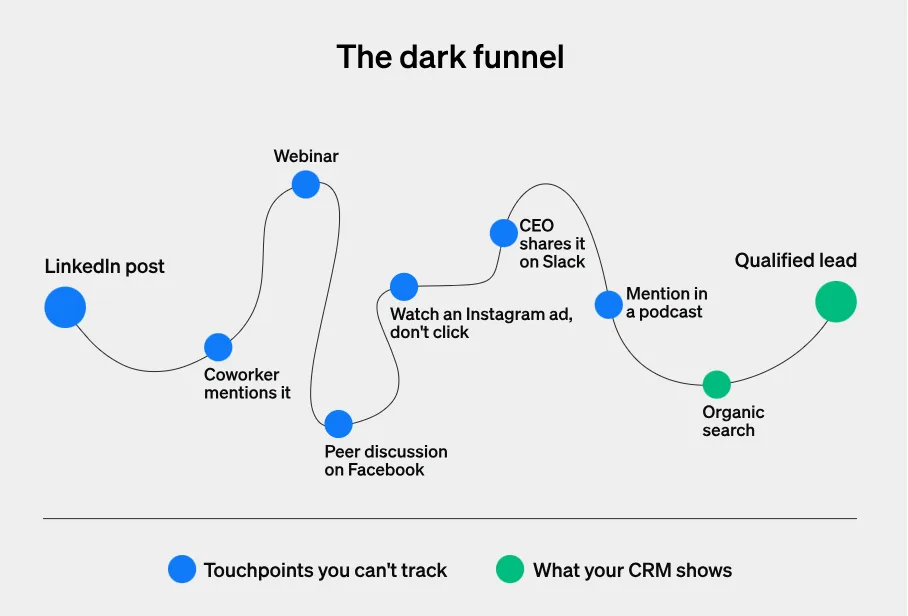Understanding the Dark Funnel in Marketing: How to Tackle the Unseen Path to Purchase
As digital marketing evolves, the way customers research, engage with, and ultimately purchase products has become more complex and less trackable. One of the most challenging aspects of this shift is the emergence of the dark funnel. This untrackable stage of the buyer’s journey represents the invisible steps your customers take before they make a purchase — and it’s growing increasingly important in today’s privacy-first world.

In this post, we’ll dive deep into what the dark funnel is, why it’s crucial to your marketing strategy, and most importantly, how you can address it to improve your customer acquisition, engagement, and retention efforts.
What Is the Dark Funnel?
The dark funnel refers to the part of the buyer’s journey that is hard or impossible to track with traditional analytics tools. It includes all the activities that happen outside of the measurable touchpoints in your marketing campaigns, such as organic social media shares, private group discussions, word-of-mouth recommendations, or content consumption that doesn’t lead to immediate conversion.
In short, it’s the “black hole” where potential customers are engaging with your brand without leaving easily measurable data behind.
For example:
- A customer might watch a YouTube video where someone talks about your product.
- They may discuss your product in a Facebook group or in a private WhatsApp conversation.
- Or perhaps they read a blog post but don’t click through to your website right away.
These interactions are not immediately visible or trackable in your analytics, but they can significantly influence the decision-making process.
Why Does the Dark Funnel Matter?
The rise of privacy laws (like GDPR and CCPA), cookie restrictions, and increasingly sophisticated ad blockers means that much of a potential customer’s journey now occurs out of sight from traditional tracking tools. What happens in the dark funnel is crucial because it influences purchasing decisions and often leads to conversions that can’t be directly attributed to any single channel.
The dark funnel is becoming larger and more impactful, making it essential for marketers to adapt their strategies to uncover this hidden customer behavior.
6 Effective Strategies to Address the Dark Funnel
Let’s take a look at six actionable strategies you can use to tackle the dark funnel and make it work for your business. These approaches can help you bridge the gap between invisible customer actions and measurable results.
1. Invest in Social Listening and Community Building
Why It Matters:
A significant portion of the dark funnel occurs in social media platforms, private groups, and communities where customers share feedback, recommendations, and content related to your product. These interactions are often untrackable but play a vital role in influencing decisions.
What to Do:
- Monitor Social Media Mentions: Use social listening tools like Brandwatch, Sprout Social, or Hootsuite to track brand mentions and discussions that happen outside your official channels. Even if someone doesn’t comment on your post or engage with a direct advertisement, they may still be talking about you elsewhere.
- Encourage Community Building: Create exclusive Facebook Groups, Slack channels, or private forums for customers to discuss your products. These spaces encourage organic conversations and word-of-mouth marketing.
- Partner with Influencers: Engage with influencers to get the conversation about your products into places you can’t directly track. Even if they don’t mention affiliate links or click-tracked posts, their influence drives brand awareness and trust.
Example:
Glossier, the skincare brand, has built an incredibly loyal following by leveraging social media and word-of-mouth within private communities. They thrive on discussions in spaces like Instagram DMs and Facebook groups, where customers share product experiences and recommendations without direct tracking.
2. Use Attribution Modeling and Multi-Touch Tracking
Why It Matters:
Traditional analytics methods often focus on first-touch or last-touch attribution, which doesn’t account for the interactions that happen in the dark funnel. Without considering these, you may miss out on understanding how these untrackable activities contribute to conversions.
What to Do:
- Implement Multi-Touch Attribution: Use attribution models that track multiple touchpoints along the customer journey. This allows you to assign credit to each interaction — whether it’s social media engagement, private recommendations, or organic content consumption.
- Integrate Data Sources: Combine data from your CRM, website analytics, and social media platforms to get a clearer picture of your customer’s journey, even if it includes untrackable actions.
Example:
HubSpot is a great example of a platform that provides multi-touch attribution. HubSpot allows marketers to track all touchpoints and understand the indirect paths that eventually lead to conversion. Even if a customer hears about your product in a private Facebook group, this interaction will be reflected in the overall attribution model.
3. Create Shareable Content for the Dark Funnel
Why It Matters:
The dark funnel often involves content that is shared via word-of-mouth or social channels. While these actions might not immediately show up in your analytics, they can create a lasting impact on your audience.
What to Do:
- Develop Shareable Content: Create high-quality, valuable content such as blog posts, case studies, infographics, and videos that customers will want to share with their network. These shares, while not directly measurable, contribute to your brand’s awareness.
- Encourage User-Generated Content (UGC): Motivate customers to create content about your product — like social media posts, unboxing videos, or reviews. UGC doesn’t always appear in tracking systems, but it can boost brand credibility and lead to conversions.
Example:
Apple is known for creating viral videos and tutorials that people share organically. The content that’s shared across social media platforms helps Apple stay top of mind, even if the company cannot directly measure all these interactions.
4. Leverage CRM Data to Predict Dark Funnel Activity
Why It Matters:
While much of the dark funnel activity happens outside traditional tracking tools, your CRM system holds valuable insights into offline interactions — such as emails, customer service inquiries, and support tickets — that can help you understand your customers’ behavior.
What to Do:
- Segment Your Customers: Use CRM data to create customer segments based on their past behaviors. For instance, if they’ve interacted with customer service or opened certain emails, they may be in the research phase but haven’t yet made a purchase.
- Automate Retargeting Campaigns: Use your CRM insights to trigger personalized emails, product recommendations, or ads based on their previous interactions, even if they didn’t directly convert via your website.
Example:
Salesforce allows businesses to track both online and offline interactions. For example, if a customer reaches out via support channels or calls your sales team, that activity can be logged and used to help nurture the customer through the dark funnel.
5. Focus on Personalization and Recommendations
Why It Matters:
Personalization is key to navigating the dark funnel because it helps guide the customer back into the measurable part of the funnel. Personalized experiences make it more likely that customers will return to your website and eventually make a purchase.
What to Do:
- Use AI to Offer Personalized Recommendations: By leveraging machine learning, you can provide personalized product suggestions based on the customer’s browsing or purchasing history, even if those actions occurred outside your site.
- Retarget with Ads: Use retargeting to reach customers who have shown interest in your products through indirect channels like social media posts or email newsletters.
Example:
Amazon is a master at personalized product recommendations. Even if customers only briefly looked at an item or clicked a product page, Amazon’s algorithm will suggest those products across their site and in retargeted ads, nudging customers back toward a purchase.
6. Use Surveys and Feedback Loops
Why It Matters:
Surveys can help you gain insights into how your customers found you, even if their actions weren’t tracked by your website or social media platforms. By asking the right questions, you can understand what’s happening in the dark funnel.
What to Do:
- Post-Purchase Surveys: After a customer makes a purchase, ask them how they found your product. Did they read an article, hear about it from a friend, or find it through an ad they don’t remember clicking?
- Customer Feedback Loops: Use feedback tools to continuously gather insights from customers, helping you refine your strategy and understand the untrackable stages of their journey.
Example:
Zappos frequently sends post-purchase surveys asking customers where they heard about the brand. This feedback helps them understand what’s happening in the dark funnel, even if those customers didn’t directly interact with an ad or email.
Conclusion: Navigating the Dark Funnel
The dark funnel is an inevitable part of today’s marketing landscape. As more interactions happen outside the direct tracking of ads, websites, and social media channels, it’s crucial to develop strategies that uncover these hidden interactions and understand how they influence purchasing decisions.
By leveraging strategies like social listening, multi-touch attribution, shareable content, CRM data, personalization, and surveys, you can bridge the gap and gain a more comprehensive understanding of your customer’s journey — even the parts that are traditionally invisible.
Embrace the dark funnel, adapt your strategies, and you’ll be able to maximize your marketing efforts while delivering more targeted and personalized experiences to your customers.

Leave a Reply